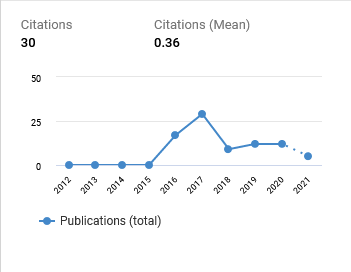Nursing Home Design Based on User's Needs and Behavioral Patterns
DOI:
https://doi.org/10.29080/eija.v8i1.1291Keywords:
Nursing Homes, Elderly, Behavioural Architecture, Elderly Behaviour, Design, nursing homes, elderly behaviour, elderly, behavioral architecture, designAbstract
Life expectancy in Indonesia has significantly increased. The 2010 census shows that the Indonesian population has a life expectancy of up to 70.7 years. As for Medan, life expectancy increased to 73.14 in 2020, with 129,063 older people. The number of residents is considered unbalanced with the number of available nursing homes, and there are still few nursing homes with adequate facilities. Nursing homes are also often seen as an act of alienation for the elderly; they are considered harmful. Therefore, nursing homes will implement a behavioural architecture, which is an architecture that, in its application, always includes considerations of user behaviour in its design. This research aims to make a nursing home a facility that can make the elderly comfortable and safe by considering their needs and behaviour patterns. The method used is a qualitative approach in which data is collected through observation, field surveys, literature studies, and comparative studies. The results show that the design of the nursing home must support and meet the needs of the elderly, who tend to require their territory, need an area with a good view, a bright and quiet environment, and can socialize easily. The results of this study can be used as a basis for designing nursing homes in the future.
Downloads
References
Bell, P. A., Fisher, J. D., & Loomis, R. J. (1978). Environmental psychology. W.B. Saunders.
BPS Kota Medan. (2020). Medan Selayang District in Figures 2019. the Central Bureau of Statistics for the City of Medan.
Chiara, J. D., & Callender, J. H. (1980). Time-saver Standards for Building Types. McGraw-Hill.
Cicilia, C. (2019). Elderly Productive House. JMARS: Jurnal Mosaik Arsitektur, 7(1), Article 1. https://doi.org/10.26418/jmars.v7i1.32554
Devi, E. (2016). Living arrangement pattern nursing home occupants based activities and behavior. ARTEKS : Jurnal Teknik Arsitektur, 1(1), Article 1. https://doi.org/10.30822/arteks.v1i1.24
Dewi, M., & Ekomadyo, A. S. (2020). Residential Adaptation in High Noise Areas. Case study: The settlement of Maleber Utara Street. EMARA: Indonesian Journal of Architecture, 6(2), Article 2. https://doi.org/10.29080/eija.v6i2.1110 DOI: https://doi.org/10.29080/eija.v6i2.1110
Hanindito, D. S. (2013). The Influence of Color and Material on Home Design for Seniors. Jurnal Intra, 1(1), 1–5.
Haryadi, H., & Setiawan, B. (2010). Architecture, environment, and behavior: An introduction to theory, methodology, and applications. Gadjah mada University Press.
Krissanti, K., Nugroho, R., & Singgih, E. P. (2017). Housing and Early Aged Services in Bogor Regency with an Emphasis on Behavior in Architecture. Arsitektura, 12(1), Article 1. https://jurnal.uns.ac.id/Arsitektura/article/view/15678
Lang, J. T. (1987). Creating Architectural Theory The Role of the Behavioral Sciences in Environmental Design. New York Van Nostrand Reinhold Co. - References—Scientific Research Publishing. Van Nostrand Reinhold Co. https://www.scirp.org/(S(i43dyn45teexjx455qlt3d2q))/reference/ReferencesPapers.aspx?ReferenceID=1226035
Luly, P. G., Tilaar, S., & Siregar, F. O. (2020). Elderly Friendly Homes in Manado. Jurnal Arsitektur Daseng, 9(1), 495–503.
Mazaya, U., Rahmi, M., & Kusuma, H. E. (2020). Investigation of Spontaneous Individual Behavior During Natural Disasters: Inside and Outside Buildings. EMARA: Indonesian Journal of Architecture, 6(2), Article 2. https://doi.org/10.29080/eija.v6i2.1084 DOI: https://doi.org/10.29080/eija.v6i2.1084
Pathak, A. (2012). ‘Form follows function’. https://www.slideshare.net/pathyapustak/form-follows-function-15146540
Ramadhani, A. N., Hayati, A., & Faqih, M. (2019). The Effect of Physical Quality Improvement to Inhabitant’s Sense of Place. EMARA: Indonesian Journal of Architecture, 5(1), Article 1. https://doi.org/10.29080/eija.v5i1.656 DOI: https://doi.org/10.29080/eija.v5i1.656
Rapoport, A. (2000). Theory, Culture and Housing. Housing, Theory and Society, 17(4), 145–165. https://doi.org/10.1080/140360900300108573 DOI: https://doi.org/10.1080/140360900300108573
Snyder, ames C., & Catanese, A. J. (1984). Introduction to architecture. McGraw-Hill. https://www.semanticscholar.org/paper/Introduction-to-architecture-Snyder-Catanese/28839ffd4cc629ae671071c2f46a4c856fddb4fc
Tandali, A. N., & Egam, P. P. (2011). Behavioral Architecture (behaviorism). Media Matrasain, 8(1), Article 1. https://doi.org/10.35792/matrasain.v8i1.314
Turana, Y. (2013). Brain stimulation in the elderly group in the community. Buletin Jendela Data & Informasi Kesehatan Semester I, 19.

Downloads
Additional Files
Published
How to Cite
Issue
Section
Categories
License
Copyright (c) 2022 Chairun Annisa, Amy Marisa

This work is licensed under a Creative Commons Attribution-ShareAlike 4.0 International License.
- Authors retain copyright and grant the journal right of first publication with the work simultaneously licensed under a Creative Commons Attribution ShareAlike License that allows others to share the work with an acknowledgment of the work's authorship and initial publication in this journal.
- Authors are able to enter into separate, additional contractual arrangements for the non-exclusive distribution of the journal's published version of the work (e.g., post it to an institutional repository or publish it in a book), with an acknowledgment of its initial publication in this journal.
- Authors are permitted and encouraged to post their work online (e.g., in institutional repositories, pre-print sites, or on their website) prior to and during the submission process, as it can lead to productive exchanges, as well as earlier and greater dissemination of published work.
































